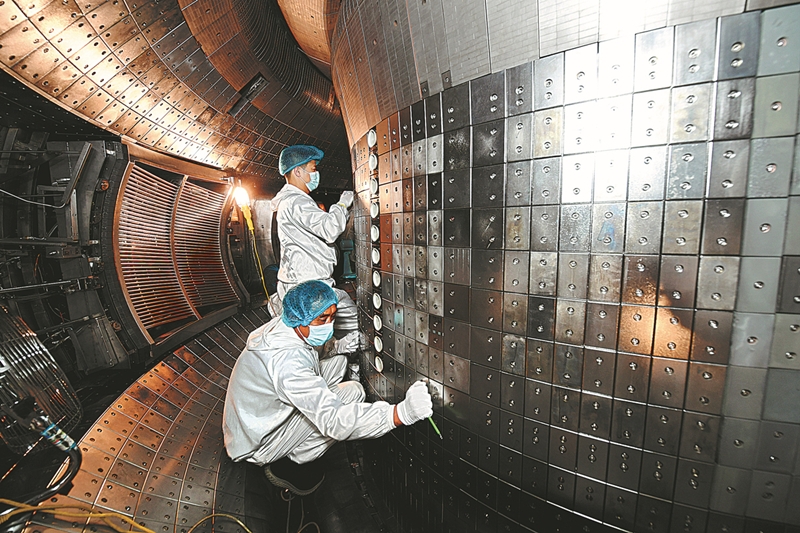Ability, potential
For Cai Tao, an associate researcher with the Tianjin Institute of Industrial Biotechnology at the Chinese Academy of Sciences, blue is not a color associated with sadness, but with hope and success.
For over six years, his team focused on a single task: how to synthesize starch in a way that is similar to the process in plants, but do it much faster.
Unlocking this insight is key for sustainability on Earth and future space exploration as it theoretically allows scientists to recycle carbon dioxide and turn this common industrial byproduct and greenhouse gas into food.
With the aid of supercomputing and clever bioengineering, Cai streamlined the complex natural starch-making process via photosynthesis into 11 steps, with the final product being starch, whose solution turns blue upon contact with iodine.
"On July 24, 2018, our solution turned light blue for the first time after hundreds of failed experiments. It was a great moment of introspection and awe," he said. "We overcame countless difficulties over the years, and for us that light blue in a tube shone like a bright ray of hope."
Cai's findings were published in the journal Science, and were celebrated by CAS as one of the biggest original breakthroughs in basic sciences last year.
Ye Yujiang, head of the Department of Basic Research at the Ministry of Science and Technology, said such studies are the source of innovation, a measure of a country's research capability and potential, and the foundation for achieving self-reliance and strength in science and technology.
Last year, China led the world in seven out of 11 broad fields in terms of active frontier research, according to the report 2021 Research Fronts, published by the Institutes of Science at CAS and Clarivate, a global analytics company.
The report identified 171 frontier research topics, from physics to clinical medicine. The list, compiled by analyzing data from highly influential and frequently cited papers published from 2015 to last year, is used to help scientists and governments identify popular and emerging scientific fields.
The seven categories of frontier research in which China excelled were: agricultural, plant and animal sciences; ecological and environmental sciences; clinical medicine; chemistry and materials science; mathematics; information science; and economics, psychology and other social sciences.
China ranked second in geosciences, biological sciences and physics, and eighth in astronomy and astrophysics, according to the report.
It added that in terms of a country's overall performance across all 11 areas, the United States topped the list, followed by China, but the gap between the two countries has been closing fast in recent years.
Pan Jiaofeng, head of the institutes, said China has maintained its advantages in chemistry and materials science, and has seen major improvements in biology and clinical medicine thanks to the major contribution the nation's scientists have made in tackling the COVID-19 pandemic.

Scientists upgrade the Experimental Advanced Superconducting Tokamak in April in Hefei, Anhui province. The "artificial sun" set a record of maintaining a temperature of 120 million C for 101 seconds. [Photo/Xinhua]
Engineering feats
On May 15, after a journey of 475 million kilometers through space and enduring a harrowing descent through the Martian atmosphere, China landed the rover Zhurong on the Red Planet, becoming only the second nation to do so after the US.
Named after an ancient Chinese god of fire, the gold-colored vehicle gently drove down its landing platform and opened its blue, butterfly wing-like solar panels, thus kick-starting Tianwen 1, China's first interplanetary adventure.
In a congratulatory letter, President Xi hailed the accomplishment as a major milestone in China's space industry as it has left the country's first "footprints" on the planet.
The journal Nature named Zhang Rongqiao, chief designer of the Tianwen 1 Mars mission, as one of the 10 people who helped shape science in the past year.
Since September, China has released nearly 200 gigabytes of geological data collected during its Mars mission, offering insights into the unexplored region of the planet's northern hemisphere, according to the journal.
In addition to Mars exploration, China has seen a series of breakthroughs in core technologies, ranging from nuclear energy to quantum computing.
In May, the Experimental Advanced Superconducting Tokamak, dubbed the "artificial sun" and located in Hefei, Anhui province, set a record of maintaining a temperature of 120 million C-eight times hotter than the center of the Sun-for 101 seconds, bringing a sustainable nuclear fusion reactor a step closer.
In October, scientists at the University of Science and Technology of China in Hefei said they had created the world's fastest programmable quantum computer, Zuchongzhi 2, a 66-qubit superconducting quantum machine named after a fifth century Chinese mathematician.
The machine is 10 million times faster than the fastest conventional supercomputer, even far surpassing Google's 55-qubit Sycamore quantum computer, which was launched in 2019, according to studies published in the journals Physical Review Letters and Science Bulletin.
Zhong Zhihua, vice-president of the Chinese Academy of Engineering, said engineering and technology are major pillars of socioeconomic growth and humanity's pursuit of sustainable development.
"As our country enters a new developmental phase, we urgently need to accelerate the pace of innovation in engineering and technology, and improve the quality of our innovation," he said.
Jeremy Lawson, senior vice-president of Clarivate, said China is currently at the forefront of many frontier engineering topics that are essential to global socioeconomic development.
As a result, strategic collaboration with key global research organizations such as CAE is central to advancing global scientific research and driving sustainable development, he added.

The Five-hundred-meter Aperture Spherical Telescope, the world's largest single-dish and most sensitive radio telescope, officially opened for global research operations on March 31. [Photo/Xinhua]
Xinhua contributed to this story.